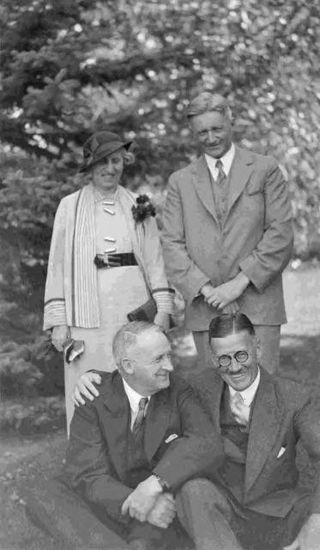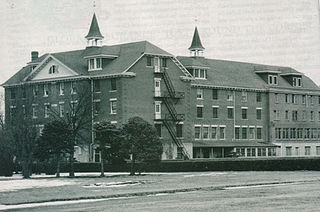
Emily Murphy was a Canadian women's rights activist and author. In 1916, she became the first female magistrate in Canada and in the British Empire. She is best known for her contributions to Canadian feminism, specifically to the question of whether women were "persons" under Canadian law.

Compulsory sterilization, also known as forced or coerced sterilization, is a government-mandated program to involuntarily sterilize a specific group of people. Sterilization removes a person's capacity to reproduce, and is usually done through surgical procedures. Several countries implemented sterilization programs in the early 20th century. Although such programs have been made illegal in most countries of the world, instances of forced or coerced sterilizations persist.

In 1924, the Virginia General Assembly enacted the Racial Integrity Act. The act reinforced racial segregation by prohibiting interracial marriage and |classifying as "white" a person "who has no trace whatsoever of any blood other than Caucasian". The act, an outgrowth of eugenicist and scientific racist propaganda, was pushed by Walter Plecker, a white supremacist and eugenicist who held the post of registrar of Virginia Bureau of Vital Statistics.

Joseph Spencer DeJarnette was the director of Western State Hospital from 1905 to November 15, 1943. He was a vocal proponent of racial segregation and eugenics, specifically, the compulsory sterilization of the mentally ill.

John Malcolm MacEachran was a Canadian philosopher and psychologist, whose most notable credentials involved the development of the Psychology and Philosophy Department at the University of Alberta. He was a co-founder of the Canadian Psychological Association and the appointed Chairman of the Alberta Eugenics Board which was responsible for approving the sterilization of thousands of Albertans, hundreds of which were without consent.
The Alberta Eugenics Board was an agency created by the Alberta government in 1928 that attempted to impose sterilization on a disabled subset of its population, in accordance with the principles of eugenics. It remained active until 1972, when it was dissolved.

Leilani Marietta (O'Malley) Muir, previously named Leilani Marie Scorah, was the first person to file a successful lawsuit against the Alberta government for wrongful sterilization under the Sexual Sterilization Act of Alberta. Her case led to the initiation of several other class action lawsuits against the province for wrongful sterilization. Muir's advocacy shed light on eugenics, institutionalisation, human rights for persons with a disability, and self-advocacy.

The 6th Alberta Legislative Assembly was in session from February 10, 1927, to May 10, 1930, with the membership of the assembly determined by the results of the 1926 Alberta general election held on June 28, 1926. The Legislature officially resumed on February 10, 1927, and continued until the fourth session was prorogued on April 3, 1930 and dissolved on May 10, 1930, prior to the 1930 Alberta general election.
Compulsory sterilization in Canada has a documented history in the provinces of Alberta, Saskatchewan, and British Columbia. It is still ongoing as in 2017, sixty Indigenous women in Saskatchewan sued the provincial government, claiming they had been forced to accept sterilization before seeing their newborn babies. In June of 2021, the Standing Committee on Human Rights in Canada found that compulsory sterilization is ongoing in Canada and its extent has been underestimated.

Eugenics, the set of beliefs and practices which aims at improving the genetic quality of the human population, played a significant role in the history and culture of the United States from the late 19th century into the mid-20th century. The cause became increasingly promoted by intellectuals of the Progressive Era.

Leonard Jan Le Vann was the medical superintendent at the Alberta Provincial Training School for Mental Defectives from 1949 to 1974. Although he was born and raised in the United States, Le Vann trained as a physician in Scotland. Throughout his career Le Vann wrote many articles, most of which were published during his 25-year career at the Provincial Training School, covering a broad range of topics including alcoholism, schizophrenia and experimental treatments of antipsychotic drugs. In 1974 Le Vann resigned from the training center after the Government of Alberta repealed the Sexual Sterilization Act. Concerns over how he ran the school were part of the Leilani Muir trial that took place in 1995. Although Le Vann was already deceased at the time of the trial, his name was brought to the court's attention on many occasions.

The Provincial Training School (PTS) for what was then termed 'Mental Defectives' in Red Deer, Alberta, Canada operated as an institution for mentally disabled children and adults between 1923 and 1977, at which time it was renamed the Michener Centre. It aimed to provide care and training to facilitate the integration of individuals with intellectual disabilities into their communities. While today it houses a service for persons with developmental disabilities, the nearly one-century-old facility is preceded by a diverse history, marked by eugenic practices like involuntary sterilization.

The Sterilization of Leilani Muir is a 1996 documentary directed by Glynis Whiting about the life and times of Leilani Muir, the first person to file a lawsuit against the Alberta provincial government for wrongful sterilization under the Sexual Sterilization Act of Alberta.

The Living Archives on Eugenics in Western Canada (LAE) is a major research project, led by philosophy Professor Robert Wilson of the University of Alberta. The LAE seeks to investigate and understand the many aspects of the eugenics movement in western Canada. The project began in 2009 and is funded by a grant from the Social Sciences and Humanities Research Council of Canada.
Susan Margaret Rogers Gunn was a Canadian activist. Gunn was the third president of the United Farm Women of Alberta (UFWA), following the presidencies of Irene Parlby (1916-1920) and Marion Sears (1920–24), and served in that role from 1924 to 1929. She was a noted "country life advocate" and detested cities.
Institutions for Defective Delinquents (IDDs) were created in the United States as a result of the eugenic criminology movement. The practices in these IDDs contain many traces of the eugenics that were first proposed by Sir Francis Galton in the late 1800s. Galton believed that "our understanding of the laws of heredity [could be used] to improve the stock of humankind." Galton eventually expanded on these ideas to suggest that individuals deemed inferior, those in prisons or asylums and those with hereditary diseases, would be discouraged from having children.
According to a 2012 survey by Statistics Canada, around 3.8 million adult Canadians reported being "limited in their daily activities due to a disability". This represented 13.7% of the adult population. The three most-prevalent forms of disability in Canada are chronic pain issues, mobility, and flexibility limitations. Around 11% of Canadian adults experience one of these disability types, and 40% of those people have had all three at the same time. Disabled people in Canada have historically experienced many forms of discrimination and abuse, such as segregation, institutionalization, and compulsory sterilization. They were not given the same rights as non-disabled people until the end of the 1970s, when the Coalition of Provincial Organizations of the Handicapped initiated significant changes. Legislation intended to protect disabled Canadians include the Charter of Rights and Freedoms, the Canadian Human Rights Act, and the Employment Equity Act.

The Virginia Sterilization Act of 1924 was a U.S. state law in Virginia for the sterilization of institutionalized persons "afflicted with hereditary forms of insanity that are recurrent, idiocy, imbecility, feeble-mindedness or epilepsy”. It greatly influenced the development of eugenics in the twentieth century. The act was based on model legislation written by Harry H. Laughlin and challenged by a case that led to the United States Supreme Court decision of Buck v. Bell. The Supreme Court upheld the law as constitutional and it became a model law for sterilization laws in other states. Justice Holmes wrote that a patient may be sterilized "on complying with the very careful provisions by which the act protects the patients from possible abuse." Between 1924 and 1979, Virginia sterilized over 7,000 individuals under the act. The act was never declared unconstitutional; however, in 2001, the Virginia General Assembly passed a joint resolution apologizing for the misuse of "a respectable, 'scientific' veneer to cover activities of those who held blatantly racist views." In 2015, the Assembly agreed to compensate individuals sterilized under the act.
Sterilization of Latinas has been practiced in the United States on women of different Latin American identities, including those from Puerto Rico and Mexico. There is a significant history of such sterilization practices being conducted involuntarily, in a coerced or forced manner, as well as in more subtle forms such as that of constrained choice. Forced sterilization was permissible by multiple states throughout various periods in the 20th century. Issues of state sterilization have persisted as recently as September 2020. Some sources credit the practice to theories of racial eugenics.

Margaret Anne Wilson Thompson C.M. Ph.D. LL.D B.A., was a prominent researcher in the field of genetics in Canada. She was a member of the Alberta Eugenics Board from 1960 to 1963, before joining the University of Toronto and the Hospital for Sick Children in Toronto to complete research on genetics and pediatrics. Thompson's work earned her the Order of Canada in 1988, although her appointment remains controversial due to her role in the eugenics movement. Thompson testified about her involvement in the Eugenics Board during the Muir v. Alberta case in 1996 and was also interviewed in a documentary about the lawsuit.













